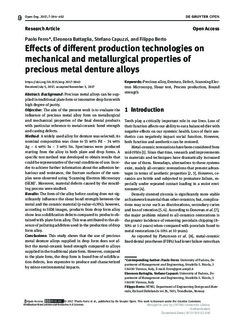| dc.contributor.author | Ferro, Paolo | |
| dc.contributor.author | Battaglia, Eleonora | |
| dc.contributor.author | Capuzzi, Stefano | |
| dc.contributor.author | Berto, Filippo | |
| dc.date.accessioned | 2018-08-13T09:18:06Z | |
| dc.date.available | 2018-08-13T09:18:06Z | |
| dc.date.created | 2018-03-11T13:37:20Z | |
| dc.date.issued | 2017 | |
| dc.identifier.citation | Open Engineering. 2017, 7 (1), 394-402. | nb_NO |
| dc.identifier.issn | 2391-5439 | |
| dc.identifier.uri | http://hdl.handle.net/11250/2557652 | |
| dc.description.abstract | Abstract: Background: Precious metal alloys can be supplied in traditional plate form orinnovative drop form with high degree of purity. Objective: The aim of the present work is to evaluate the influence of precious metal alloy form on metallurgical and mechanical properties of the final dental products with particular reference to metal-ceramic bond strength and casting defects. Method: A widely used alloy for denture was selected; its nominal composition was close to 55 wt% Pd – 34 wt% Ag – 6 wt% In – 3 wt% Sn. Specimens were produced starting from the alloy in both plate and drop forms. A specific test method was developed to obtain results that could be representative of the real conditions of use. In order to achieve further information about the adhesion behaviour and resistance, the fracture surfaces of the samples were observed using ‘Scanning Electron Microscopy (SEM)’. Moreover, material defects caused by the moulding process were studied. Results: The form of the alloy before casting does not significantly influence the shear bond strength between the metal and the ceramic material (p-value=0,976); however, according to SEM images, products from drop form alloy show less solidification defects compared to products obtained with plate form alloy. This was attributed to the absence of polluting additives used in the production of drop form alloy. Conclusions: This study shows that the use of precious metal denture alloys supplied in drop form does not affect the metal-ceramic bond strength compared to alloys supplied in the traditional plate form. However, compared to the plate form, the drop form is found free of solidification defects, less expensive to produce and characterized by minor environmental impacts. | nb_NO |
| dc.language.iso | eng | nb_NO |
| dc.publisher | De Gruyter | nb_NO |
| dc.rights | Attribution-NonCommercial-NoDerivatives 4.0 Internasjonal | * |
| dc.rights.uri | http://creativecommons.org/licenses/by-nc-nd/4.0/deed.no | * |
| dc.title | Effects of different production technologies on mechanical and metallurgical properties of precious metal denture alloys | nb_NO |
| dc.type | Journal article | nb_NO |
| dc.type | Peer reviewed | nb_NO |
| dc.description.version | publishedVersion | nb_NO |
| dc.source.pagenumber | 394-402 | nb_NO |
| dc.source.volume | 7 | nb_NO |
| dc.source.journal | Open Engineering | nb_NO |
| dc.source.issue | 1 | nb_NO |
| dc.identifier.doi | 10.1515/eng-2017-0043 | |
| dc.identifier.cristin | 1571913 | |
| dc.description.localcode | © 2017 TPaolo Ferro et al., published by De Gruyter Open. This work is licensed under the Creative Commons Attribution-NonCommercial-NoDerivs 4.0 License. | nb_NO |
| cristin.unitcode | 194,64,92,0 | |
| cristin.unitname | Institutt for maskinteknikk og produksjon | |
| cristin.ispublished | true | |
| cristin.fulltext | original | |
| cristin.qualitycode | 1 | |

